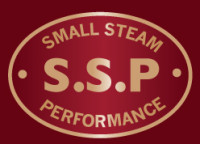Question: Will a Slomo cause wear in my loco ?
Answer: Well, maybe.
Misconception: Many people believe that the Slomo is a braking device that loads the loco to slow it down.
Fact: The Slomo is not a braking device, it does not use friction or drag to slow a loco.
The Slomo is not intended to slow the loco. It helps the locomotive run smoother, so it can be run at lower regulator settings and hence slower speeds.
Overview: Many factors effect the operation of garden variety live steam locomotives.Including:
Leakage of slide valves, drops of water or oil in the steam supply to the valves/pistons. Accuracy of Valve timing, quartering of the main cranks, and other variables.
These can cause a momentary loss of power being applied to the main cranks/axles/wheels by the pistons. (A dead spot)!
Intermittent or partial jamming in bearings, bushes, linkages, (A tight spot)
High spots, low spots, tight spots, etc in the track.
When we try to run a small (Garden rail) loco at very low regulator settings/speed, the main cranks/axles/wheels will often hesitate or stop at a “dead spot” or a “tight spot” because these small locos have very little inherent momentum relative to their size.
“If only we could add extra momentum to the driving axles/ wheels”.
The Slomo uses a gear train driven by the driving axle/cranks to spin a flywheel and store rotational energy. (extra momentum perhaps?).
! When the cranks/axles/wheels of a Loco encounter a “dead spot” or a “tight spot” and start to hesitate, the Slomo applies energy from the spinning flywheel to the driving axles/wheels, carrying the loco past those spots.
So installing a Slomo means that the loco can be run at a lower regulator setting, and hence, lower speed.
The Slomo does add extra load when a loco is accelarating or decelerating,(smoothing out starts and stops) which may cause some components to wear slightly faster, however if the loco is mostly run at slower speeds, then the components will travel through less cycles per hour of running, so it could be argued that there will be less wear.
Conclusion:
Does a Slomo increase wear on my loco?
The answer is an absolute and unequivocal, “I don`t really know”. If it does, I would guess it would be the same as adding an extra wagon to your train.
So for me at least. If a slomo means my trains perform as I want them to, then I am quite ok with the thought that maybe, and it`s a small maybe, I will need to repair something on my loco in nine and a half years time rather than ten.
